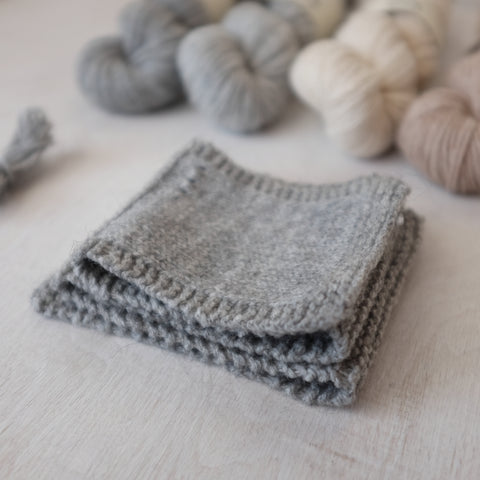We are pleased to announce our newest yarn, Gather, made of 75% California Rambouillet and 25% Arizona Alpaca.
I am here today to tell you the story of how Gather came to be because I love to explore the intricacies of how things come to be, and how they are made. I mean, I love yarn, so yeah, that could be enough, right there and then, but there is so much more, why not share it? Especially because it is full of knots! And why are knots exciting, I don't know - ask any number of twisted knitters who enjoy untangling skeins of yarn.
I like things that fit nicely into neat boxes. Is that my Midwestern upbringing? Perhaps a genetic disposition - following in line with the women in my families disposition of cataloguing and organizing anything; cookbooks to bank statements (for fun). I look around the internet and see others' lives of well-organized, structured intentions, design, their products executed beautifully, and want to cry wishing that I could do the same. Well, my story of making yarn is anything but neat and tidy. It's actually quite messy. And at some point, isn't it just better to embrace the chaos? Maybe? With the hope in the future, things will get ironed out. That with each experience we learn more, and we adapt, grow, and design.
Perhaps one day my mind's eye will land here on planet Earth. If so, here is what it would look like: a collection of yarns made from local wool, local dyes, and milled locally. To have a yarn which supports local farms, has a low carbon footprint, and is a yarn people want to knit with.
Instead let's look at our current reality:
Horizon, our first farm yarn is made from organic Merino wool raised by Sally Fox, about 90 miles away. Flock is sometimes made of Sally's wool. And sometimes it is made of wool grown about 100 miles away from here in Boonville. All of this wool is shipped to Green Mountain Spinnery in Vermont where it is milled organically into yarn, and then shipped back to us to be sold in either its natural state or naturally-dyed in our studio, and then placed on the sale floor where you buy it, and then make it into beautiful blankets, sweaters, scarves, and so forth. We buy wool locally to support local farmers, so they can keep farming, but also wanting to keep our carbon footprint low...except the wool is traveling across the country. And back. But. Sally grows organic cotton on the same land which supports her sheep. And there she is sequestering a great amount of carbon due to the deep roots of the cotton. So does that make up for the transportation? And we love Green Mountain Spinnery, and want to continue to support that. Oy! So in this case, we can check off the box of sourcing locally-grown wool and supporting our local farmers, we can definitely check the box of people liking to knit with it (thank goodness!), but the carbon footprint....eeeeh, kinda sorta but not ideal.
I am always poking around exploring possibilities of other mills who could make out yarn, and who are closer to us. My friend Mary, who is the owner of Twirl yarn, suggested I meet with the Rob and Donna who own Mystic Pines Mill in Northern Arizona. Last June, I was headed to Flagstaff to give a keynote speech at their wool festival. I flew in a couple days early so I could visit the mill.
Rob and Donna gave Adrienne and I a tour of the mill. As we walked around the property, Rob explained that when they decided to live in this rural, high-desert area, it was cost-prohibitive to drill a well. So they decided to install a large water tank in the ground, to build their house on top of it, and to make their house a large water catchment. Off of their roof, they collect the water which heats their house, is used in their bathrooms, etc. From there, the water goes into another storage tank, and is then used at the mill to wash wool. I was (and still am) so impressed with the way they cohabitate with the environment. Part of our tour included visiting their alpaca, I always love hearing their sweet cooing purrs. Walking into the mill, it was filled with vintage equipment Rob has collected and sourced from around the US. We had a lovely time and begin thinking about how to incorporate Mystic Pines into our work at Verb.
About 4 months later, we purchased a very large amount of Rambouillet wool from Lani Estill and had it sent to Mystic Pines for milling into yarn. Our intention was to create a new batch of our farm yarn, Range. However, there was a hiccup in the marketplace, and we decided to forgo creating this yarn again, and discontinued it instead. We also at this time had the idea to create a new version of our yarns Even Tinier Annapurna and Annapurna. Currently, these yarns are made from imported materials and milled in Canada. The samples we received of these yarns are beautiful, though, the hand is very different, and I have a hard time believing the customer who is drawn to knit with Annapurna would want to knit with this new yarn instead. Ok, back to the drawing board.
One day, I was sitting here in the studio - and it dawned on me - what if we were to create a yarn combining the Rambouillet wool with Rob and Donna's alpaca. I sent over an email to them, and sure enough they were into the idea. So we set out on creating 4 natural colors. And today, we can now offer you our newest yarn, Gather.
So back to my mind's eye. How does this yarn fit within my framework of goals. The wool comes from the border of California and Nevada. I like Lani's wool because it has a beautiful hand, it is available in large quantities, it is consistent, and affordable. Also, Lani is committed to farming carbon. Lani's wool is more affordable because she raises wool on a very large scale. She sends about 10,000 pounds of wool to be processed in the South. So darn, here we are, we have California wool, are supporting a California rancher, but are sending the wool across the country. Though at least the alpaca comes from the mill, is washed and processed at the mill, and then comes here. So that's good!
Once I had Gather in my hot little hands, I couldn't wait to cast-on. A gauge swatch is the first thing I made. Starting with a size 3 needle, I knit about 4 inches, and then moved to a size 4 needle, I kept going all the way to a size 7 needle and still the fabric looked great! The Rambouillet wool creates a round yarn, with lots of bounce, and the alpaca adds softness, the range of natural colors, and a blooming halo. This yarn is incredibly versatile and can be knit at 6.5 stitches per inch for a denser fabric and up to 5 stitches per inch for a fabric with drape and flow.
Once my gauge swatch was knit, blocked, and catalogued, I moved onto looking for knitting patterns. I always try to focus on those who are currently designing for our Pro-Verbial Yarn, Fiber, & Shawl Club - so when I came across Caitlin Hunter's Glacier Park Cowl design, it seemed like a perfect fit. I used two skeins: one in lighthouse, and one in smoke. The pattern was easy to knit, and I love the finished cowl. It only took about a week of evening-time knitting to complete making it a great option as a gift for a loved one.


So this is your update as to one person's reality of processing US-based yarn in 2018. Thank you for going on this journey with all of us at Verb! You can find Gather on our website and in our Oakland shop.
-- Kristine
P.S. We are releasing our first every Fall Look-book November 1st - stay tuned for new patterns!






